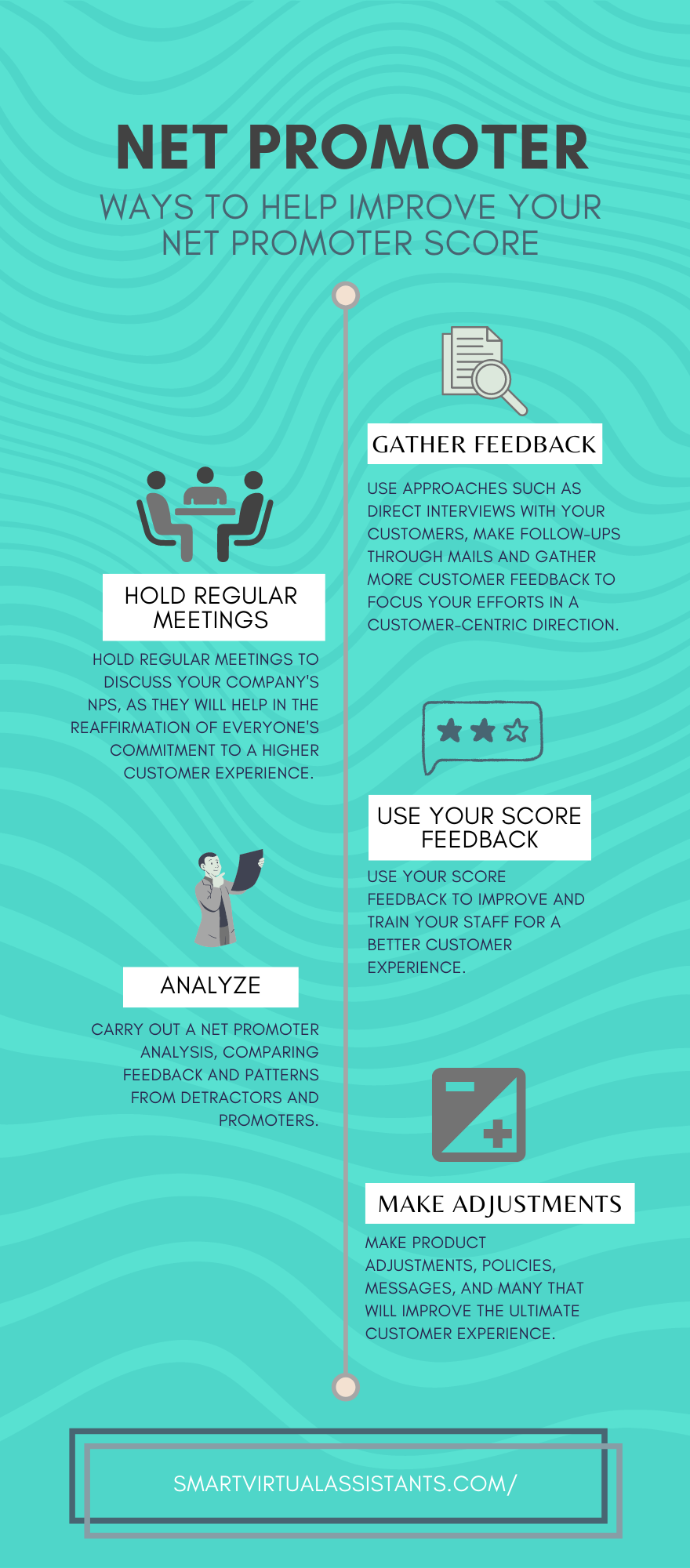Your Ultimate Guide to Net Promoter Score & How Do You Measure It
Your ultimate guide to Net Promoter & how do you measure it
What is a Net Promoter Score?
Measuring your customer's experience is one of the most vital elements you can do as a business owner. When you correctly collect information and act on it, you can use the feedback you get from customers to improve your products and services, adjust and refine your marketing strategies and inform your sales strategies. The net promoter score of your business is where all the magic begins! Not only does it help you improve customer experience, but it also drives your business growth. It helps you gauge your loyal customers through short surveys.
Net promoter is also defined as a scope that shows you the willingness of clients to mention your product or service to other users in the product market. NPS determines or indicates the overall customer satisfaction of your company’s product and the user’s allegiance to your brand. Understanding the customer experience gives the marketer information that would be cumbersome to acquire otherwise, given the fears about privacy. Once you are aware of customers' feelings, behavior, and thoughts, you can offer superior services to your customers, thus growing your business from the loyalty of customers and repeat sales.
The Ultimate Guide to your Net Promoter and how to Measure It:
Begin by choosing a survey program, the number of surveys to be created, and what goes into each one of them.
Secondly, choose a relationship survey over a transactional survey because relationship surveys will investigate customer's loyalty to your brand. In contrast, a transactional survey will help you determine a customer's experience in a specific interaction but does not measure loyalty.
Thirdly, identify the duration of your NP survey because you want to uncover customer loyalty and aspects that affect it. Remember, you need to do more than asking the paramount question stated above. Consider a maximum of four questions.
Identify the kind of questions you would like to use for the surveys because asking your customers what drove them to their score is necessary. Remember to keep your questions short and simple.
For your relationship survey, use touchpoints such as mapping out the customer's journey and select those touchpoints with high customer success.
The sixth guideline is your sample size. Most business owners would wonder just how many customers should they survey. This should, however, not be a worry during your first survey. Depending on your customer base, release the survey in good time, and with time you can narrow down your sample size.
Identify an ideal day during the week and time to send out the surveys
Identify the best channels that you will use to send Net Promoter Surveys for your customer’s convenience.
Have a good statement for your survey invite
Ensure you test your Net promoter survey first, for instance, within the organization.
Finally, create a consistent and actionable Net Promoter score for your business.
Transactional vs Relational NPS Programs
Transactional NPS focuses on capturing customer feedback and loyalty based on specific transactions or interactions with a company. It measures how likely a customer is to recommend a company or its product/service based on their recent experience. Transactional NPS provides valuable insights into immediate customer satisfaction and helps identify areas for improvement in specific touchpoints or processes.
On the other hand, Relational NPS takes a broader and more holistic approach by assessing the overall relationship between a customer and a company over an extended period. It looks at the cumulative experiences and interactions a customer has had with the company, encompassing multiple touchpoints and interactions. Relational NPS provides a more comprehensive view of customer loyalty, engagement, and long-term satisfaction.
How Net Promoter Predicts Business Growth?
The net promoter is the most significant indicator of your brand's success, and it gives you as a marketer or the business owner perceptions into the customer loyalty spectrum. The more your score becomes higher, customers defect at lower rates, you change from a negative referral to a positive one, your referrals increase, and so do your product sales from both existing and new clients.
Your net promoter score improves customer experience because once you get feedback from customers, you use it as a baseline for customers' sentiment, thus focusing on their happiness. Unlike traditional methods, a Net promoter is a strategic way that gives your business the best results and scales it to greater heights.
Having learned what Net promoter is, how it enhances customer experience and predicts business growth, we now take you through calculating NPS.
Importance of Measuring NPS
Knowing your Net Promoter Score (NPS) is important as it provides valuable insights into your customers' loyalty and satisfaction levels. NPS serves as a key performance indicator that helps businesses gauge how likely their customers are to recommend their products or services to others. By understanding your NPS, you can assess the overall health of your customer relationships and identify areas for improvement. A high NPS indicates strong customer loyalty, positive word-of-mouth referrals, and potential for business growth. Conversely, a low NPS signals areas of concern and the need to address underlying issues to prevent customer churn. By actively monitoring and analyzing your NPS, you can make data-driven decisions, implement targeted strategies, and enhance customer experiences, ultimately leading to increased customer retention, improved brand reputation, and sustained business success.
How do you Calculate the Net Promoter Score?
Calculating your Net Promoter score is very simple. Once you have identified your detractors and promoters, you subtract the percentage of detractors from the percentage of promoters.
Net promoter involves asking customers a simple question. "How likely are you to recommend our business to someone else, your friend, family, or colleague"? From this question, customers will give their answers varyingly on a scale of 1-10. Given your customer's responses, you can calculate your score and determine how customers feel about your business.
Any NPS above 0 is considered good. This means that people buying from you are more loyal. Any customer who gives you a score below 6 is regarded as a detractor. Those customers who give you a 7 and 8 score are referred to as passives, while 9 and 10 are promoters. Any score above 20 is considered favorable, and a score above 50 is considered an excellent one. If your company gets a score above 80, then consider your business world-class.
Net promoter score is important because you get to gauge the quality of your customer service, especially in relation to your competing brands. You can use their net promoter score to address any difficulty in different business areas, expand and enhance your customer experience, check loyalty inclinations, and drive revenue through referrals and sales.
Measuring customer satisfaction allows businesses to identify reasons for dissatisfaction. By doing so, you can implement the essential enhancement wits before customers abandon your brand.
Suppose your NPS is low;
Here are Few Ways to Help Improve your Net Promoter Score:
Use approaches such as direct interviews with your customers, make follow-ups through mails and gather more customer feedback to focus your efforts in a customer-centric direction.
Hold regular meetings to discuss your company's NPS, as they will help in the reaffirmation of everyone's commitment to a higher customer experience. Provide forums for employees to discuss product escalations and brainstorm on possible solutions.
Use your score feedback to improve and train your staff for a better customer experience.
Carry out a Net Promoter analysis, comparing feedback and patterns from detractors and promoters.
Make product adjustments, policies, messages, and many that will improve the ultimate customer experience.
If you are in business and not familiar with Net Promoter, we highly recommend you to read this article and identify your ultimate guide and how to measure it. You will learn much about its importance and take advantage of NPS to scale your business to greater heights.
Frequently Asked Questions:
1. What is a good Net Promoters Score?
A good Net Promoter Score (NPS) typically falls within the range of 50 to 70. However, it's important to note that what constitutes a "good" NPS can vary across industries and markets. Generally, an NPS above 50 indicates a high level of customer satisfaction, loyalty, and positive recommendations. A score above 70 is considered exceptional and suggests that a significant majority of customers are promoters of the brand. A high NPS reflects a strong brand reputation, effective customer engagement, and a positive customer experience. However, it's essential to analyze the NPS in conjunction with other metrics, industry benchmarks, and qualitative feedback to gain a comprehensive understanding of the overall customer sentiment and areas for improvement. Monitoring trends in NPS over time allows businesses to track progress, identify patterns, and implement targeted strategies to continuously enhance customer satisfaction and loyalty.
2. What are 3 categories of NPS?
The Net Promoter Score (NPS) is typically categorized into three groups based on the scores obtained:
Promoters:
Promoters are customers who respond to the NPS survey with a score of 9 or 10. They are highly satisfied and loyal customers who are likely to recommend the brand to others. Promoters are considered brand advocates and can contribute to positive word-of-mouth referrals, helping to attract new customers and drive business growth.
Passives:
Passives are customers who respond to the NPS survey with a score of 7 or 8. They are generally satisfied with the brand but not as enthusiastic or loyal as promoters. Passives may not actively promote the brand but are still likely to continue their business with the company. While they may not actively detract from the brand, they are more susceptible to competitive offerings and may switch to another brand if presented with a compelling alternative.
Detractors:
Detractors are customers who respond to the NPS survey with a score of 0 to 6. They are dissatisfied customers who may have had negative experiences or encountered issues with the brand. Detractors are at risk of spreading negative word-of-mouth and can have a detrimental impact on the brand's reputation and customer base. Addressing the concerns and resolving issues of detractors is crucial to mitigate their potential negative influence and convert them into more satisfied customers.
Analyzing the distribution of scores across these three categories helps businesses understand the overall sentiment of their customer base, identify areas for improvement, and focus efforts on converting detractors into promoters.



